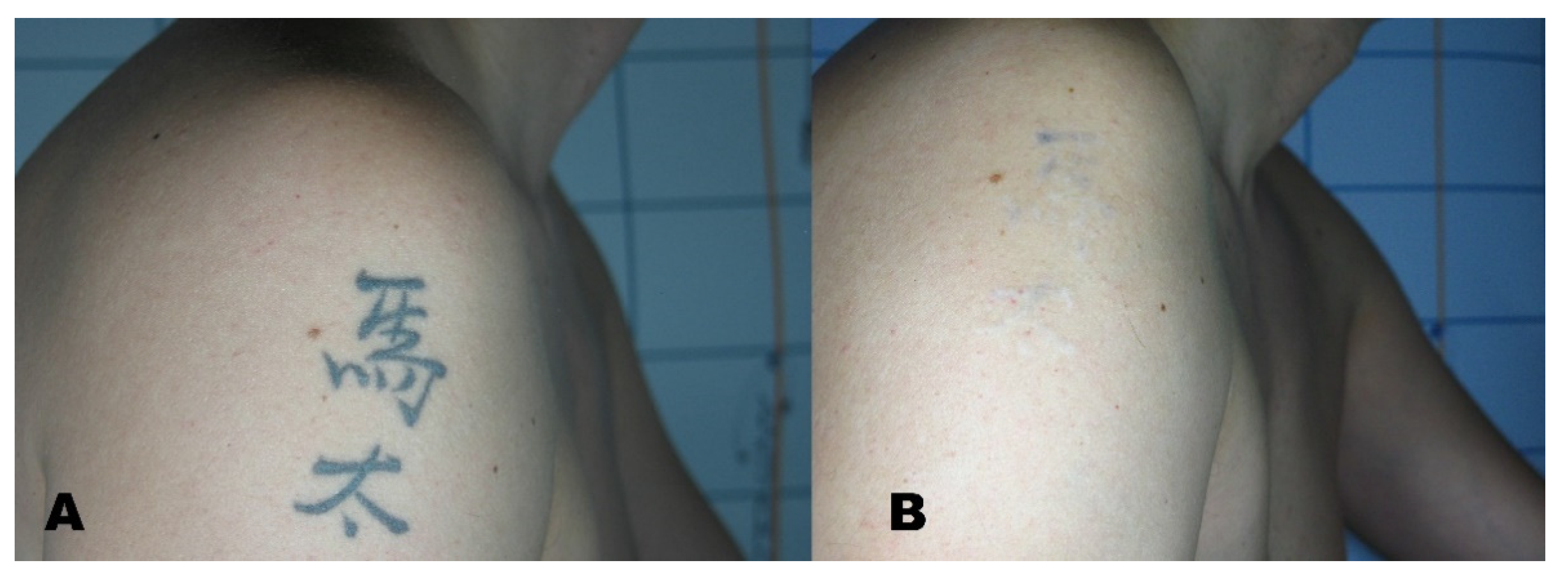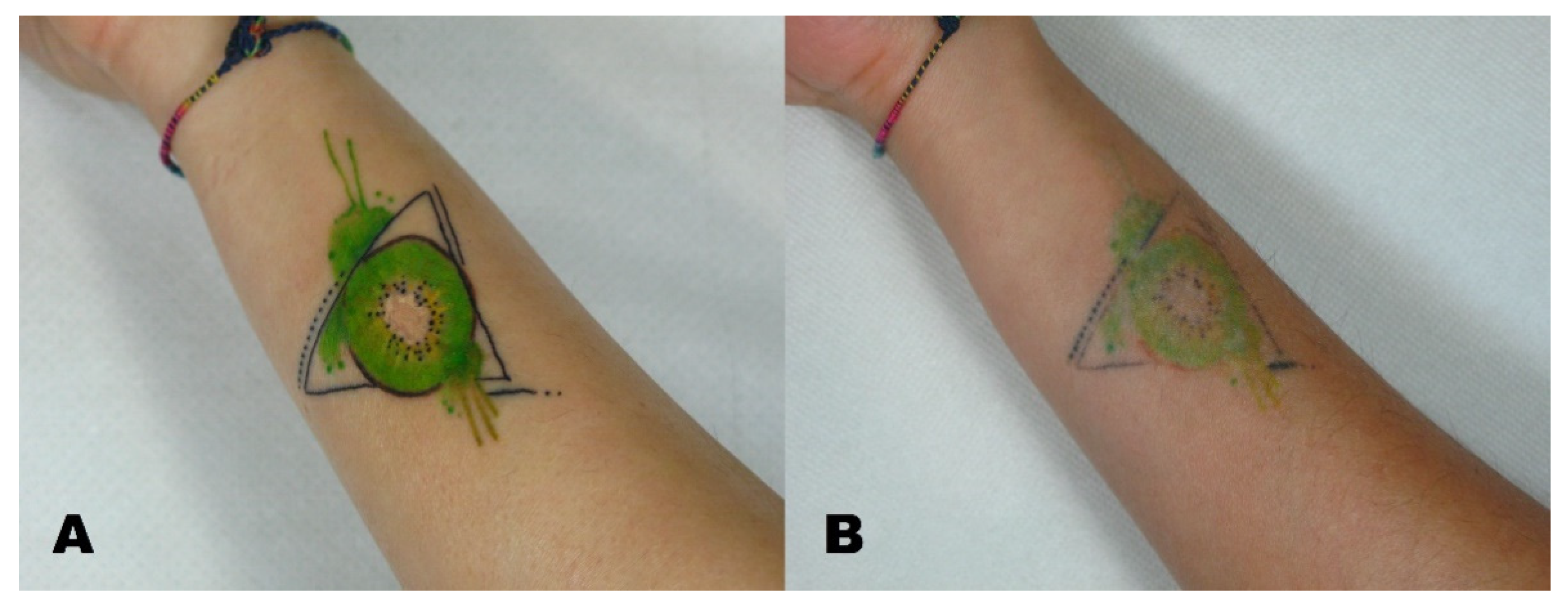Q-Switched 1064/532 nm Laser with Nanosecond Pulse in Tattoo Treatment: A Double-Center Retrospective Study
Abstract
:1. Introduction
2. Materials and Methods
3. Results
4. Discussion
5. Conclusions
Author Contributions
Funding
Institutional Review Board Statement
Informed Consent Statement
Data Availability Statement
Acknowledgments
Conflicts of Interest
References
- Witkoś, J.; Hartman-Petrycka, M. Gender Differences in Subjective Pain Perception during and after Tattooing. Int. J. Environ. Res. Public Health 2020, 17, 9466. [Google Scholar] [CrossRef]
- Kluger, N.; Misery, L.; Seité, S.; Taieb, C. Regrets after tattooing and tattoo removal in the general population of France. J. Eur. Acad. Dermatol. Venereol. 2019, 33, e157–e159. [Google Scholar] [CrossRef]
- Zhitny, V.P.; Iftekhar, N. Tattoo Removal: A Practice from Ancient Times. Dermatology 2020, 236, 390–392. [Google Scholar] [CrossRef] [PubMed]
- Kim, M.; Park, S.; Lee, H.U.; Kang, H.W. Quantitative Monitoring of Tattoo Contrast Variations after 755-nm Laser Treatments in In Vivo Tattoo Models. Sensors 2020, 20, 285. [Google Scholar] [CrossRef] [PubMed] [Green Version]
- Mercuri, S.R.; Brianti, P.; Dattola, A.; Bennardo, L.; Silvestri, M.; Schipani, G.; Nisticò, S.P. CO2 laser and photodynamic therapy: Study of efficacy in periocular BCC. Dermatol. Ther. 2018, 31, e12616. [Google Scholar] [CrossRef]
- Cannarozzo, G.; Bennardo, L.; Negosanti, F.; Nisticò, S.P. CO2 Laser Treatment in Idiopathic Scrotal Calcinosis: A Case Series. J. Lasers Med. Sci. 2020, 11, 500–501. [Google Scholar] [CrossRef]
- Lajevardi, V.; Mahmoudi, H.; Karimi, F.; Kalantari, Y.; Etesami, I. Comparing QS Nd:YAG laser alone with its combination with fractional ablative Er:YAG in tattoo removal. J. Cosmet. Dermatol. 2021. [Google Scholar] [CrossRef]
- Kurniadi, I.; Tabri, F.; Madjid, A.; Anwar, A.I.; Widita, W. Laser tattoo removal: Fundamental principles and practical approach. Dermatol. Ther. 2021, 34, e14418. [Google Scholar] [CrossRef] [PubMed]
- Goldust, M.; Wollina, U. Periorbital Hyperpigmentation—Dark Circles under the Eyes; Treatment Suggestions and Combining Procedures. Cosmetics 2021, 8, 26. [Google Scholar] [CrossRef]
- Del Duca, E.; Zingoni, T.; Bennardo, L.; Di Raimondo, C.; Garofalo, V.; Sannino, M.; Petrini, N.; Cannarozzo, G.; Bianchi, L.; Nisticò, S.P. Long-Term Follow-Up for Q-Switched Nd:YAG Treatment of Nevus of Ota: Are High Number of Treatments Really Required? A Case Report. Photobiomodul Photomed. Laser Surg. 2021, 39, 137–140. [Google Scholar] [CrossRef] [PubMed]
- Cannarozzo, G.; Negosanti, F.; Sannino, M.; Santoli, M.; Bennardo, L.; Banzola, N.; Negosanti, L.; Nisticò, S.P. Q-switched Nd:YAG laser for cosmetic tattoo removal. Dermatol. Ther. 2019, 32, e13042. [Google Scholar] [CrossRef] [PubMed]
- Kirby, W.; Desai, A.; Desai, T. The Kirby-Desai Scale: A proposed scale to assess tattoo removal treatments. J. Clin. Aesthet. Dermatol. 2009, 2, 32–37. [Google Scholar] [PubMed]
- Khunger, N.; Molpariya, A.; Khunger, A. Complications of Tattoos and Tattoo Removal: Stop and Think Before you ink. J. Cutan. Aesthet. Surg. 2015, 8, 30–36. [Google Scholar] [CrossRef]
- Eklund, Y.; Rubin, A.T. Laser tattoo removal, precautions, and unwanted effects. Curr. Probl. Dermatol. 2015, 48, 88–96. [Google Scholar] [CrossRef]
- Laux, P.; Tralau, T.; Tentschert, J.; Blume, A.; Dahouk, S.A.; Bäumler, W.; Bernstein, E.; Bocca, B.; Alimonti, A.; Colebrook, H.; et al. A medical-toxicological view of tattooing. Lancet 2016, 387, 395–402. [Google Scholar] [CrossRef]
- Kato, H.; Doi, K.; Kanayama, K.; Araki, J.; Nakatsukasa, S.; Chi, D.; Mori, M.; Fuse, Y.; Sakae, Y.; Uozumi, T. Combination of Dual Wavelength Picosecond and Nanosecond Pulse Width Neodymium-Doped Yttrium-Aluminum-Garnet Lasers for Tattoo Removal. Lasers Surg. Med. 2020, 52, 515–522. [Google Scholar] [CrossRef] [PubMed]
- Lorgeou, A.; Perrillat, Y.; Gral, N.; Lagrange, S.; Lacour, J.P.; Passeron, T. Comparison of two picosecond lasers to a nanosecond laser for treating tattoos: A prospective randomized study on 49 patients. J. Eur. Acad. Dermatol. Venereol. 2018, 32, 265–270. [Google Scholar] [CrossRef]
- Karsai, S. Removal of Tattoos by Q-Switched Nanosecond Lasers. Curr. Probl. Dermatol. 2017, 52, 105–112. [Google Scholar] [CrossRef]
- Pinto, F.; Große-Büning, S.; Karsai, S.; Weiß, C.; Bäumler, W.; Hammes, S.; Felcht, M.; Raulin, C. Neodymium-doped yttrium aluminium garnet (Nd:YAG) 1064-nm picosecond laser vs. Nd:YAG 1064-nm nanosecond laser in tattoo removal: A randomized controlled single-blind clinical trial. Br. J. Dermatol. 2017, 176, 457–464. [Google Scholar] [CrossRef]
- Naga, L.I.; Alster, T.S. Laser Tattoo Removal: An Update. Am. J. Clin. Dermatol. 2017, 18, 59–65. [Google Scholar] [CrossRef]
- Serup, J.; Bäumler, W. Guide to Treatment of Tattoo Complications and Tattoo Removal. Curr. Probl. Dermatol. 2017, 52, 132–138. [Google Scholar] [CrossRef] [PubMed]
- Hsu, V.M.; Aldahan, A.S.; Mlacker, S.; Shah, V.V.; Nouri, K. The picosecond laser for tattoo removal. Lasers Med. Sci. 2016, 31, 1733–1737. [Google Scholar] [CrossRef] [PubMed]
- Hutton Carlsen, K.; Esmann, J.; Serup, J. Tattoo removal by Q-switched yttrium aluminium garnet laser: Client satisfaction. J. Eur. Acad. Dermatol. Venereol. 2017, 31, 904–909. [Google Scholar] [CrossRef] [PubMed]
- Pedrelli, V.; Azzopardi, E.; Azzopardi, E.; Tretti Clementoni, M. Picosecond laser versus historical responses to Q-switched lasers for tattoo treatment. J. Cosmet. Laser Ther. 2020, 22, 210–214. [Google Scholar] [CrossRef]




| Class | Specifications |
|---|---|
| Dark group (professional) | Performed by qualified personnel using mostly black-colored ink compositions |
| Red group (professional) | Performed by qualified personnel using ink compositions with predominantly red-colored pigments |
| Mixed color group (professional) | Performed by qualified personnel using multiple color and ink compositions |
| Amateur | Performed by unqualified personnel and usually lighter than professional tattoos |
| Medical | In cases of radiotherapy, usually dark blue in color, relatively superficial |
| Traumatic (natural) | Caused by various agents, with an unknown composition |
| Cosmetic (permanent makeup) | Performed by expert personnel using a mixture of components that often contain ferric oxide |
| Patient No. | 52 |
|---|---|
| Female (%) | 30 (57.7%) |
| Male (%) | 22 (42.3%) |
| Mean age ± SD (years) | 43.7 ± 12.7 |
| Age range (years) | 23–62 |
| Fitzpatrick phototype: | |
| II (%) | 16 (30.8%) |
| III (%) | 15 (28.8%) |
| IV (%) | 21 (40.4%) |
| Tattoo type: | |
| Professional (%) out of which: | 25 (48.1%) |
| Dark group (%) | 9 (17.3%) |
| Red group (%) | 4 (7.7%) |
| Mixed color group (%) | 12 (23.1%) |
| Amateur (%) | 9 (17.3%) |
| Medical (%) | 7 (13.5%) |
| Traumatic (%) | 7 (13.5%) |
| Cosmetic (%) | 4 (7.7%) |
| Tattoo location: | |
| Face/head (%) | 11 (21.2%) |
| Upper trunk/shoulder (%) | 18 (34.6%) |
| Lower trunk/upper leg (%) | 3 (5.8%) |
| Lower arm/leg (%) | 12 (23.1%) |
| Wrist/hand/ankle/foot (%) | 8 (15.4%) |
| No. Patients (%) | Mean No. Sessions ± SD | No. Sessions Range | |
|---|---|---|---|
| Total | 52 (100%) | 4.6 ± 2.5 | 2–9 |
| Tattoo removal score | |||
| 3 (60–80%) | 25 (48.1%) | 4.7 ± 2.6 | 2–9 |
| 4 (80–100%) | 27 (51.9%) | 4.6 ± 2.5 | 2–9 |
| Mean No. Sessions ± SD | No. Sessions Range | Tattoo Removal Score 3 (60–80%) (n; %) | Tattoo Removal Score 4 (80–100%) (n; %) | |
|---|---|---|---|---|
| Fitzpatrick phototype: | ||||
| II | 4.6 ± 2.9 | 2–9 | 6 (37.5%) | 10 (62.5%) |
| III | 4.3 ± 2.5 | 2–8 | 10 (66.7%) | 5 (33.3%) |
| IV | 4.9 ± 2.3 | 2–9 | 9 (42.9%) | 12 (57.1%) |
| Tattoo Type: | ||||
| Professional: | ||||
| Dark group | 6.3 ± 0.9 | 5–8 | 4 (44.4%) | 5 (55.6%) |
| Red group | 6.5 ± 0.6 | 6–7 | 2 (50.0%) | 2 (50.0%) |
| Mixed color group | 7.8 ± 1.1 | 6–9 | 6 (50.0%) | 6 (50.0%) |
| Amateur | 2.3 ± 0.5 | 2–3 | 4 (44.4%) | 5 (55.6%) |
| Medical | 2.3 ± 0.5 | 2–3 | 5 (71.4%) | 2 (28.6%) |
| Traumatic | 2.6 ± 0.5 | 2–3 | 4 (57.1%) | 3 (42.9%) |
| Cosmetic | 2.3 ± 0.5 | 2–3 | 0 (0.0%) | 4 (100.0%) |
| Tattoo location: | ||||
| Face/head | 2.5 ± 0.5 | 2–3 | 4 (36.4%) | 7 (63.6%) |
| Upper trunk/shoulder | 4.2 ± 2.0 | 2–7 | 10 (55.6%) | 8 (44.4%) |
| Lower trunk/upper leg | 5.7 ±2.3 | 3–7 | 2(66.7%) | 1 (33.3%) |
| Lower arm/leg | 5.3 ± 2.5 | 2–8 | 6 (50.0%) | 6 (50.0%) |
| Wrist/hand/ankle/foot | 7.0 ± 2.9 | 2–9 | 3 (37.5%) | 5 (62.5%) |
Publisher’s Note: MDPI stays neutral with regard to jurisdictional claims in published maps and institutional affiliations. |
© 2021 by the authors. Licensee MDPI, Basel, Switzerland. This article is an open access article distributed under the terms and conditions of the Creative Commons Attribution (CC BY) license (https://creativecommons.org/licenses/by/4.0/).
Share and Cite
Cannarozzo, G.; Nisticò, S.P.; Zappia, E.; Del Duca, E.; Provenzano, E.; Patruno, C.; Negosanti, F.; Sannino, M.; Bennardo, L. Q-Switched 1064/532 nm Laser with Nanosecond Pulse in Tattoo Treatment: A Double-Center Retrospective Study. Life 2021, 11, 699. https://doi.org/10.3390/life11070699
Cannarozzo G, Nisticò SP, Zappia E, Del Duca E, Provenzano E, Patruno C, Negosanti F, Sannino M, Bennardo L. Q-Switched 1064/532 nm Laser with Nanosecond Pulse in Tattoo Treatment: A Double-Center Retrospective Study. Life. 2021; 11(7):699. https://doi.org/10.3390/life11070699
Chicago/Turabian StyleCannarozzo, Giovanni, Steven Paul Nisticò, Elena Zappia, Ester Del Duca, Eugenio Provenzano, Cataldo Patruno, Francesca Negosanti, Mario Sannino, and Luigi Bennardo. 2021. "Q-Switched 1064/532 nm Laser with Nanosecond Pulse in Tattoo Treatment: A Double-Center Retrospective Study" Life 11, no. 7: 699. https://doi.org/10.3390/life11070699
APA StyleCannarozzo, G., Nisticò, S. P., Zappia, E., Del Duca, E., Provenzano, E., Patruno, C., Negosanti, F., Sannino, M., & Bennardo, L. (2021). Q-Switched 1064/532 nm Laser with Nanosecond Pulse in Tattoo Treatment: A Double-Center Retrospective Study. Life, 11(7), 699. https://doi.org/10.3390/life11070699








